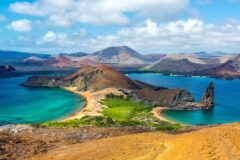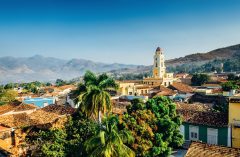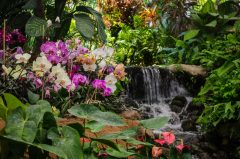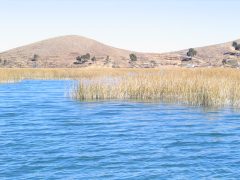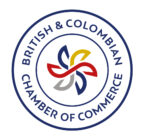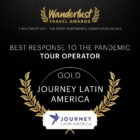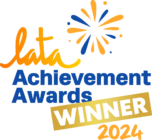Private Journeys
Active Peru and Bolivia: trekking Andean peaks to tropical rainforest
17 days from £4,070pp
(based on two people sharing & excluding flights)
Itinerary
 Map
Map
Day 1
Arrive in Lima and transfer to hotel.
You will be met at the airport and escorted to your hotel in the cliff-side Pacific residential and commercial district of Miraflores. The drive to the hotel, through Lima’s outskirts, encapsulates the invigorating buzz of a modern-day Latin American capital.

Stay at -
El Tambo Hotel
Day 2
Tour of Lima by car, ending at the airport for flight to Cusco.
Lima is a vast, complex metropolis, with a history dating from the era of its wealth and importance to Imperial Spain to its current status as a dynamic, growing city of trade, industry and tourism.
Plaza San Martín, with its colonial churches, promenades and palaces marks the beginning of a guided tour that unearths much of the country’s turbulent past. En route, visit several palaces including the Torre Eagle Palace (built for the treasurer of the Royal Spanish fleet and considered to be the most striking of Lima’s 18th century mansions). Another building which borrows its architectural style from Baroque and Moorish Spain is the Monastery of San Francisco with its fascinating library and catacombs.
The final port of call is the private Larco Museum with its collection of beautifully modelled pottery, unique gold and silver work, mummies, and ceramics from pre-Inca civilisations. Afterwards, continue to the airport for a 1 hour flight to Cusco.
The name Cusco derives from the Quechua word for navel, indicating its location at the centre of the Inca Empire, which reached its zenith at the same time as England was fighting the War of the Roses. It is said that the city was originally built in the shape of a puma and its position atop the precipitous foothills of the Andes is without doubt a commanding one. Capital of the Inca Empire and latterly a strong hold to the Spanish conquistadors, Cusco is not so much a blend of architectures as a defiant mix.
Today its many impressive original Inca walls display extraordinary craftsmanship, while the bustling squares are dotted with ornate baroque colonial churches. It’s a vivacious city, where shoeshine boys and postcard sellers jostle for your attention in cobbled streets lined with handicraft shops and cafés. In the evening, the town centre fills with people flocking to the many restaurants, bars and cafés.

Stay at -
Hotel Rumi Punku
Day 3
Walking tour of Cusco and nearby Inca ruins.
Today you’ll have a guided walking tour of the city, the centre of which is compact and easy to get around on foot. Beyond the squares, museums, churches and markets, you’ll visit some impressive ruins on the outskirts: Tambomachay, Puca Pucara and the monumental Sacsayhuamán, with its foreboding cyclopean fortress.
While the edges of Cusco are dominated by Inca dwellings, temples and fortresses, the historic heart (with the Plaza de Armas flanked by the cathedral and the church of La Compañia) reveal the indelible mark of the Spanish conquistadors.

Stay at -
Hotel Rumi Punku
Day 4
Guided exploration of the Sacred Valley of the Incas.
Drive through stunning countryside, against a backdrop of the snow-capped Andes to the high plains of Chinchero. On market days the neat colonial plaza of the eponymous village is awash with colour and noise, its inhabitants dressing in traditional costume. The nearby ruins of Tupa Inca are remarkably well preserved and overlook the Royal Inca Road which stretches as far as Chile in the south and Ecuador in the north.
Continue to the agricultural terraces of Moray, an Inca site used as an experimental agricultural centre to develop complex farming. It comprises numerous terraces carved into a large, natural amphitheatre, each one with a different microclimate.
Then head onwards to the Maras saltpans. These are a series of terraces where a natural source of saline water is evaporated by the strong Andean sun. In use since Inca times, the saltpans continue to be worked by the local community and present a unique sight, with their flat, white surfaces contrasting with the green, vertical scenery surrounding them. From here, there’s a 3km walking trail which descends to the Urubamba where your vehicle awaits for the return journey to Cusco.

Stay at -
Hotel Rumi Punku
Day 5
Hike the Salkantay Trail.
The Salkantay Trail clings to the skirts of the eponymous snow-mantled mountain peak (6,271m), crossing high-altitude, chilly pampa grasslands indented with icy lagoons before plunging through steamy cloud-forest and plantations heavy with tropical flowers and succulent fruit to the Santa Teresa river. From here it is a short hop by train to Peru’s most mesmerising attraction, the Lost City of the Incas, Machu Picchu.
You’ll savour panoramic mountain and valley views throughout which are truly out of this world. En route you will pass through small hamlets and farmsteads, where people continue to live a traditional lifestyle. Popular with walkers and horse-riders, the trek offers an excellent alternative to the classic Inca Trail for those happy to reach the citadel from a different, but still staggeringly beautiful, trekking route.
Set off by road to the start of the Salkantay Trek at Sayllapata where you meet your guides and the mules which carry the majority of the camping gear.

Day 6
Second day of the Salkantay trek.
Climb to the highest pass of the trek (4,800m), including a steep zig-zag stretch of narrow path where any pain of exertion is mitigated by tremendous views of the Andes including the monumental snow-capped peaks of Salkantay. Pass through surreal landscapes, towered over by huge rock formations. Mists may swirl languidly above you until a break in the clouds reveals majestic ice-jacketed peaks. You may even find yourself crunching through snow, while a bright sun sears through the sky above.
Continue through the valley, passing small villages along the way. You’ll see a variety of wildlife, particularly birds. Arrive at your lunch site, Wayraq, and afterwards it is a scenic descent towards your second campsite, Chaullay.

Day 7
Descending to the valley.
After an early start descend towards Collpapamba (2,600m), and hike along an easy trail through the high jungle terrain with coffee, cocoa and fruit plantations. You may even see Peru’s national bird if you’re lucky – gallito de la rocas – before arriving in the village of Playa to overnight.
The terrain changes rapidly as you descend through Santa Teresa valley, leaving the chilly moors of the sparse rocky landscape behind while dense foliage replaces the scrub. Climb into the cloud forest through narrow jungle tracks framed by spider bamboo, its spindly fronds dangling above you. All around is greenery, making it easy to spot the colourful exotic plants poking through, such as the ‘dancing lady’ orchid and bushes tinted with tiny wild raspberries. Fresh mint lining the path was much used by the Incas. The weather is warming up: it may be hot and humid now.

Day 8
Arrive Machu Picchu.
Begin the day with the ascent to Lucmabamba pass (2,400m) followed by a beautiful trail through the cloud forest to Patallaqta (also known as Llactapata) ruins. From here you get your first sight of Machu Picchu, shyly straddling a steep mountain saddle in the middle distance, and a vast tableau unfurls in front of you.
It is true that the first glimpse of the ruins on the traditional Inca Trail is spectacular but it is compromised by the sight of the motor road taking buses up to the ruins. The views here display a natural theatre seemingly untouched by human enterprise. After lunch descend to the bridge over the Aobamba river and arrive at the Hidroeléctrica railway halt in time to catch the afternoon train to Machu Picchu village (30mins). Overnight in a hotel in the village.

Stay at -
Inti Punku Machu Picchu
Day 9
Guided tour of the ruins. Return to Cusco by rail and road.
The majestic ruined city, reclaimed from tropical cloud forest, was discovered by the American explorer Hiram Bingham in 1911, by which time it was completely buried beneath jungle vegetation. It soon became clear to excavators that the conquistadors had never found the city. It is perhaps the ruins’ location, on a ridge spur amid forested peaks and above a roaring river canyon, that most ignites the imagination. You will have an early morning guided tour of the ruins along one of the pre-defined circuits.
Return by train as far as Ollantaytambo or Poroy, before continuing the journey to Cusco, and your hotel, by road. The train service offers you the chance to appreciate the scale of the ever-changing scenery, with portrait windows alongside your seat. There are windows in the roof, so you can gaze up to the rim of the canyon. Your comfort is enhanced with air-conditioning and heating, and Andean music is played as a backdrop to the passing scenery.

Stay at -
Hotel Rumi Punku
Day 10
Tourist coach to Puno and transfer to hotel.
Transfer to the bus station for the tourist coach service to Puno on Lake Titicaca.
The lonely road follows the fertile Urubamba valley, through fields of crops and livestock and adobe villages, up to a windswept grassy plain framed by jagged mountains.
During the journey there are short stops at: Andahuaylillas, where the town’s ornate, baroque 17th-century church has beautiful frescoes and an impressive gilded altar; Huaro; Raqchi, for the Temple to Viracocha, the largest roofed building ever built by the Incas and one of Peru’s most stunning Inca sites; and Pucará, famous for its pre-Inca ruins and local pottery, where you can visit the little museum. There is an English-speaking guide, complimentary soft drinks and a toilet on board.
Upon arrival, transfer to your hotel in Puno, a lively university town and port on Lake Titicaca. It’s an important centre for Peruvian folklore, enjoying a rich tradition of music and dance. It is also a great place for buying local handicrafts.

Stay at -
Hotel Intiqa
Day 11
By road to Copacabana, Bolivia. Guided lake excursion to Sun Island.
Early in the morning leave your hotel in Puno for a delightful, scenic 2.5hr drive to the Peru-Bolivia border town of Kasani. Continue on into Bolivia, where brightly coloured flowers often line the route. Arrive at Copacabana, a small town doubling as a religious sanctuary overlooked by a steep hill accommodating the 12 stations of the cross. It sits by a sandy beach on a beautiful bay, and attracts many pilgrims who make the trip, often from great distances, on foot.
Board a motor-powered sailing boat or hydrofoil and head towards Sun Island (Isla del Sol), the legendary birth place of the Inca Empire – on the island you’ll take a 25-minute scenic walk along Inca trails to your hotel in time for lunch. Afternoon at leisure to explore the island trails, dotted with ancient ruins and tiny villages, and not a car or road in sight.

Stay at -
Posada del Inca Isla del Sol
Day 12
Continue to La Paz by road.
In the morning, visit the Inca Stairs and Sacred Water Spring, supposed to be a source of eternal youth, followed by lunch at the Uma Kollu restaurant, which has panoramic lake views from its balcony and Inca walls. Afterwards, return to Copacabana by hydrofoil, visit the Shrine of the Dark Virgin and town. Then, board the bus to Huatajata (1½ hrs) and visit the Andean Eco-Village at Hotel Inca Utama. The project encompasses all aspects of local culture and nature, and includes reed boat and altiplano museums, a handicrafts workshop, mortuary towers and botanical garden. Continue overland to La Paz (1 hrs). (Although travelling on shared transport services you will be accompanied by your own guide, who will lead you around the visitor sites on a private basis.)

Stay at -
Hotel Rosario
Day 13
Tour of La Paz
Visit the historical centre of La Paz, seeing sites including the Government Palace, National Congress building and the impressive cathedral, that all surround Plaza Murillo. Continue to the Gold Museum, the 16th century San Francisco Church and pass by the Tiwanaku culture open-air museum. Explore one of the city’s more unusual markets, the Mecardo de las Brujas (witches’ market) where you can find cures for everything from heartaches to headaches. Pass through the affluent neighbourhoods of Obrajes, Calacoto and San Miguel before taking a short drive, following the river road to Moon Valley – not a valley at all, but a fantastic landscape of gullies and spires formed from an ancient bed of eroded rock. Return to La Paz.

Stay at -
Hotel Rosario
Day 14
First day of the Choro Trail to Chairo.
Begin the Choro trek. This is Bolivia’s top trek, and for good reason. You need to be pretty fit, but the route is not technically difficult. Mostly downhill, it drops from the altiplano at 3,700m to a balmy valley at 1,300m in less than three days, passing through a kaleidoscope of different landscapes, vegetation, climate and human cultures. Part of the trail is Inca (and even pre-Inca)-paved, and the route is clear, offering great views across near-vertical cliffs towards misty hillsides, negotiating rickety bridges over deep gorges and tumbling streams, and passing tiny, isolated villages. One of the pleasures of this trek is meeting a few of the small number of inhabitants; these mountain people are a hardy breed whose harsh way of life in inhospitable terrain has changed little over the centuries: it can be a humbling experience.
Depart around 7am for La Cumbre, first driving across the city and then continuing up through the suburbs, already lively with people heading off to work and school. Eventually the buildings thin out and you are climbing up through a broad valley of exposed rock framed by craggy pewter grey peaks until reaching a broad plain with a lagoon. Ahead of you is a small hill topped with a statue; to the right is the old road to Coroico, known as the Death Road, now used principally by cyclists. From there the road descends to the village of Chucura – around 40km from La Paz – where you begin walking at an altitude of around 3,700m.
From Chucura, the walk sets off down a pre-Inca trail which is well paved, although the stones are slippery. If it’s clear (it’s often misty) you will observe rapidly changing vegetation, as a warmer climate supports ferns, evergreen bushes, and even some flowers. Continue walking for around 7 hours or so to the campsite at Buena Vista (2,276m) where you’ll set up for the night and enjoy dinner.

Day 15
Second day of the trek.
Chances are you’ll be setting off from Buena Vista wearing lighter clothes than first thing yesterday. The path – a mix of up and down – remains quite well preserved showing the creativity and skill of the pre-Inca Tiwanaku culture. These trails were used for trade between highland and subtropical zones. The rivers of clear water, which you’ll cross over on bridges, are tributaries of the Amazon system. In the afternoon the vegetation becomes denser as you enter the cloud forest, and along the way you will see plenty of wildflowers – and weather permitting be treated to some great views. After 6-7 hours, arrive at camp in the village of Sandillani (1,971m).

Day 16
Third day of the trek and return to la Paz
Today the terrain is moister and vegetation even more lush and abundant – and you’ll certainly feel the humidity. The path seems to defy geography with its multiple twists and turns – a series of hairpin bends, descending via cascades used by locals for consumption and agriculture. Along the way are banana and coffee plantations, butterflies and tropical birds. After around 3 hours’ walking, arrive at the small village of Chairo (1,264m), where a vehicle awaits for the ride back to the high altitude chill and city of La Paz.
Enjoy your last night in La Paz, where there are a number of excellent restaurants to choose from to celebrate your achievements on this exhilarating holiday.

Stay at -
Hotel Rosario
Day 17
Transfer to La Paz international airport.
Outline itinerary
Day 1
Arrive in Lima and transfer to hotel.
Day 2
Tour of Lima by car, ending at the airport for flight to Cusco.
Day 3
Walking tour of Cusco and nearby Inca ruins.
Day 4
Guided exploration of the Sacred Valley of the Incas.
Day 5
Hike the Salkantay Trail.
Day 6
Second day of the Salkantay trek.
Day 7
Descending to the valley.
Day 8
Arrive Machu Picchu.
Day 9
Guided tour of the ruins. Return to Cusco by rail and road.
Day 10
Tourist coach to Puno and transfer to hotel.
Day 11
By road to Copacabana, Bolivia. Guided lake excursion to Sun Island.
Day 12
Continue to La Paz by road.
Day 13
Tour of La Paz
Day 14
First day of the Choro Trail to Chairo.
Day 15
Second day of the trek.
Day 16
Third day of the trek and return to la Paz
Day 17
Transfer to La Paz international airport.
Inspired by this trip
Our exciting range of articles on Latin America explore everything from iconic destinations and lesser-known cultural gems to delicious traditional recipes. You’ll also find exclusive travel tips, first-hand client reviews and the chance to get your personal questions answered by our travel experts.
Papagaio
Your edit for Latin American inspiration
Our exciting range of articles on Latin America explore everything from iconic destinations and lesser-known cultural gems to delicious traditional recipes. You’ll also find exclusive travel tips, first-hand client reviews and the chance to get your personal questions answered by our travel experts.
View Extraordinary Inspiration